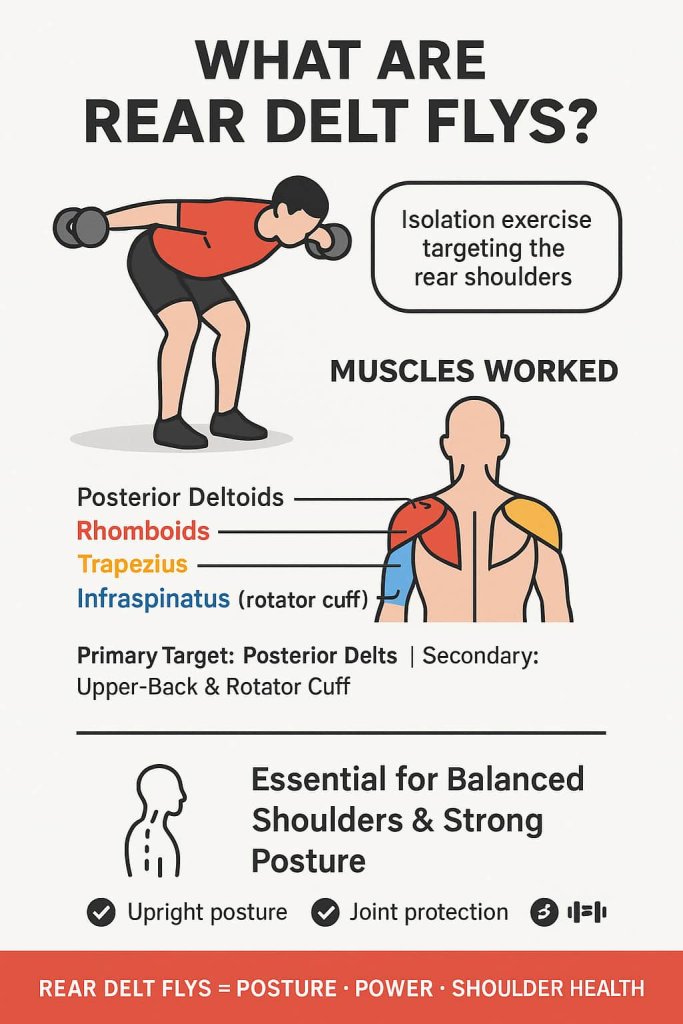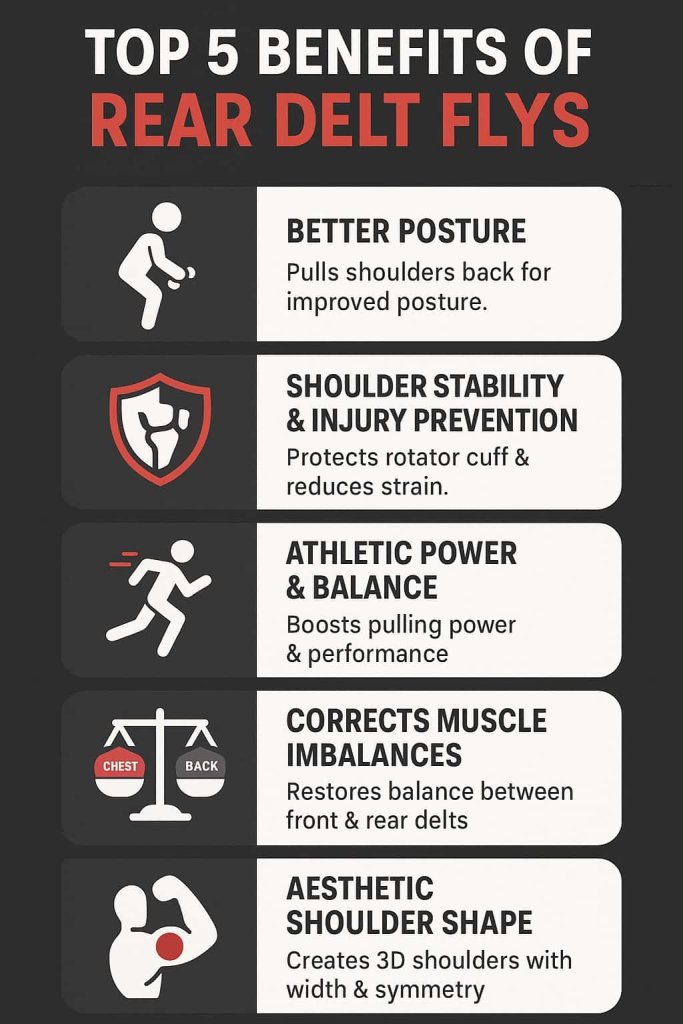Yes, rear delt flys are one of the most effective exercises for improving posture, building upper-back power, and preventing shoulder imbalances.
They specifically target the posterior deltoids—the often-neglected muscles at the back of your shoulders. Strengthening these helps counteract rounded shoulders from too much pressing (bench press, push-ups) or long hours sitting at a desk.

Rear delt flys are simple, versatile, and can be done with dumbbells, cables, or machines. Whether you’re an athlete, office worker, or weightlifter, mastering this move is a game-changer for posture, power, and injury prevention.
In this guide, we’ll cover benefits, muscles worked, variations, step-by-step form, common mistakes, and training tips so you can maximize results safely.
What Are Rear Delt Flys?
Rear delt flys (also called reverse flys or rear lateral raises) are an isolation exercise for the posterior deltoids. The movement involves spreading your arms outward while hinging at the hips or using a machine, focusing on squeezing the upper back.

- Primary Target: Posterior deltoids
- Secondary Muscles: Rhomboids, trapezius, infraspinatus (rotator cuff), and core stabilizers
This makes them essential for balanced shoulder development and upper-back strength.
Benefits of Rear Delt Flys

1. Better Posture
Strengthening rear delts pulls the shoulders back, combating forward rounding caused by computers, driving, or excessive chest training.
2. Shoulder Stability & Injury Prevention
A strong posterior shoulder reduces stress on the rotator cuff, lowering the risk of strains from pressing or overhead lifts (American Council on Exercise, 2024).
3. Athletic Power & Balance
From sprinters to weightlifters, strong rear delts improve arm drive, pulling power, and overhead stability, directly boosting performance.
4. Corrects Muscle Imbalances
Most lifters over-train front delts and pecs. Rear delt flys restore balance, giving a healthier shoulder joint and better symmetry (Onnit Academy, 2024).
5. Aesthetic Shoulder Shape
Well-developed rear delts complete the “3D shoulder look,” adding width and roundness from all angles.
How to Do Dumbbell Rear Delt Flys (Step-by-Step)
- Setup: Hold dumbbells with a neutral grip (palms facing each other). Hinge at the hips about 45°–60° forward, keeping back straight.
- Start Position: Arms hang below shoulders with a slight bend in the elbows.
- Movement: Lift both arms out to the sides in a wide arc until they align with your shoulders. Focus on squeezing your shoulder blades together.
- Lower Slowly: Return under control to starting position.
- Breathing: Exhale as you lift, inhale as you lower.
Trainer Tip: Avoid shrugging—keep traps relaxed and move with control.
Rear Delt Fly Variations
1. Cable Rear Delt Fly
Why it works:
The cable machine provides constant tension throughout the entire range of motion, unlike dumbbells where resistance is highest only at certain points.
How to do it:
- Stand in the middle of a cable crossover station with pulleys set at shoulder height.
- Grab the left handle with your right hand and the right handle with your left hand (crossed grip).
- With a slight bend in your elbows, pull the cables out to the sides in a wide arc until your arms are straight out.
- Slowly return under control.
Trainer Tip: Keep your chest lifted and avoid leaning back—this keeps the tension on your rear delts instead of your traps. Reverse Pec Deck (Machine)
2. Rear Delt Fly Machine or Reverse Pec Deck (Machine)
Why it works:
The rear delt fly machine is a beginner-friendly variation because it locks you into the correct motion path, ensuring strict form and reducing the chance of using momentum.
How to do it:
- Sit on the machine facing the pads with handles set to the rear fly position.
- Grab the handles with palms facing inward.
- Keeping a slight bend in your elbows, move your arms backward in a wide arc until they are straight out to your sides.
- Slowly return to the starting position with control.
Trainer Tip: Adjust the seat height so the handles align with your shoulders. This ensures the rear delts, not traps or lats, do most of the work.
3. Incline Bench Rear Delt Fly
Why it works:
Lying chest-down on an incline bench gives your torso support, eliminating momentum and forcing your rear delts to do all the work.
How to do it:
- Set an incline bench to 30–45 degrees and lie chest-down holding dumbbells.
- Let your arms hang straight down, palms facing each other.
- With a slight elbow bend, lift the dumbbells out to the sides until arms are parallel to the ground.
- Lower under control.
Trainer Tip: Think about moving with your elbows, not your hands—this ensures your delts, not your traps, are leading the lift.
4. Single-Arm Rear Delt Fly
Why it works:
Working one arm at a time fixes muscular imbalances and allows you to focus on the mind-muscle connection.
How to do it:
- Hold a dumbbell or cable handle in one hand.
- Bend at the hips with your torso almost parallel to the floor.
- With a slight elbow bend, lift your arm out to the side until it’s in line with your shoulder.
- Lower with control and repeat.
Trainer Tip: Place your free hand on a bench for stability—this lets you isolate the working side more effectively.
5. Band Rear Delt Fly
Why it works:
This portable and joint-friendly variation is ideal for home workouts, warm-ups, or shoulder prehab. Bands also provide variable resistance—harder at the end of the movement, where your delts are strongest.
How to do it:
- Anchor a resistance band at chest height.
- Hold both ends with arms extended in front of you.
- Pull the band apart in a wide arc until your arms are straight out to the sides.
- Return with control.
Trainer Tip: Use lighter bands for activation and warm-up sets, then progress to heavier bands for strength work.
Common Mistakes to Avoid
- ❌ Using momentum (swinging arms instead of controlled lift)
- ❌ Shrugging traps (stealing work from the delts)
- ❌ Too much weight (form breaks, risk of strain)
- ❌ Not squeezing scapula (loses rear delt activation)
- ❌ Short range of motion (arms not reaching shoulder level)
Who Should Do Rear Delt Flys?
Rear delt flys are not just for bodybuilders—they benefit nearly everyone.
- Beginners: Great entry-level shoulder isolation exercise using light dumbbells or bands.
- Intermediate & Advanced Lifters: Essential for balanced shoulder development and correcting imbalances from heavy pressing.
- Athletes: Improves arm drive, pulling strength, and shoulder stability—key for sprinters, swimmers, rowers, and throwers.
- Desk Workers & Students: Helps counteract forward-rounded shoulders from long hours of sitting.
- Older Adults: Strengthens postural muscles and supports long-term joint health with low weight, high reps.
👉 If you want better posture, healthier shoulders, and more defined arms, rear delt flys belong in your routine.
Programming: How Many Sets & Reps?
- For strength & size: 3–4 sets of 10–15 reps
- For endurance/posture: 2–3 sets of 15–20 reps
- Frequency: 2–3 times per week (with 48 hours rest between sessions)
Combine with pressing and pulling exercises for a balanced shoulder routine.
FAQs About Rear Delt Flys
1. Are rear delt flys good for beginners?
Yes—start with light dumbbells or resistance bands to learn form before progressing.
2. Should I go heavy on rear delt flys?
No. Focus on form and control. Rear delts respond best to moderate weight and higher reps.
3. Can rear delt flys fix rounded shoulders?
They help by strengthening muscles that pull the shoulders back, but combining with stretching of chest muscles is most effective.
4. How often should I train rear delts?
2–3 times per week is optimal, depending on your split and recovery.
5. Are cables better than dumbbells for rear delts?
Cables provide constant tension, but dumbbells and machines are equally effective if done with proper form.
6. Do rear delt flys work traps?
Yes, but only as stabilizers. To avoid overusing traps, keep shoulders down and focus on rear delt squeeze.
7. What’s the difference between rear delt flys and lateral raises?
Lateral raises target the side delts, while rear delt flys emphasize the back delts for posture and pulling power.
Conclusion
Rear delt flys are a must-have exercise for anyone wanting stronger, healthier, and more balanced shoulders. They correct posture, prevent injury, and add power for both athletes and everyday movers.
👉 Add them to your routine 2–3 times a week using dumbbells, cables, or machines, and you’ll notice better posture, stronger lifts, and more defined shoulders.
